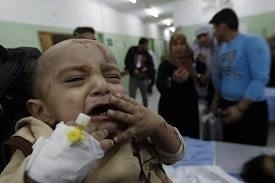By Soad Khibya
“The phantom of death looms over Eastern Ghouta, and painful hunger has overcome the mothers of this eastern suburb of Damascus. Hunger is unmercifully killing their children,” says Samah, a volunteer field nurse, as she describes the story of Farah Atout, a one year old girl. For a year now the residents of this suburb have been under siege, turning their existence into a living nightmare.
A mother hurries into the field hospital in a state of panic. Her daughter, Farah, is unconscious, foaming at the mouth. The child looks like a skeleton or a malnourished corpse. The mother lays the child on a leather seat. This makeshift hospital is still functioning despite the lack of everything but patients. Volunteers scramble to provide what they can, given the limited resources. Farah’s mother, herself on the verge of collapsing from hunger, begs the doctor to see her dying child.
The doctor scans the child’s body with his stethoscope. His facial expressions hint at bad news. There is no need to question the patient, with her skinny frail body, her white eyelids, and her paper thin skin—these are all signs of severe malnutrition. “What are you feeding her?” he asks.
It’s a painful question for the poor woman besieged in this place for months now.
“I have three children and this is the youngest,” said the mother. “I boil some lentils and give her the water to drink. My breasts have been dry for four months now, since a mortar fell in front of our house and killed my husband.
The fear and terror of that incident dried the milk of this poor woman and left her alone with her three kids.
“Can’t you give her milk?” the doctor asks. “Can’t you drink some milk to compensate?” The young mother smiles, her eyes tearing up. “We barely have water, where do you want me to get milk?”
The doctor looks at her glazed eyes and says in a robotic monotone voice, “You are too late.”
This is an everyday scene in this cut-off part of Syria. Since October 2012 it has been under a siege that has only been reinforced over the last five months. Nothing is allowed in; water, electricity, heating oil, food, even communication lines and mobile coverage are blocked. More than 1.15 million people are under siege in the Eastern Ghouta area, according to local councils. Almost half of these people, 43%, are children.
Hungry children dream of a piece of bread or a drop of milk.
According to Dr. Ibrahim, most of the patients in this field hospital are children, and 40% of those children are under one year old. They suffer severe cases of malnutrition, diarrhea resulting from malnutrition, and they lack basic nutrients.
Unable to breastfeed their children, hungry mothers are forced to use alternative sources of food in order to satisfy the hunger of their children. They boil any edible items; herbs, vegetables, whatever they can find. There is no medicine. There are no antibiotics, no nausea treatments, not even basic serums. This past November, seven children died from hunger in the city of Douma, an Eastern suburb of Damascus.
Most children under the age of eleven in Eastern Ghouta are suffering from diarrhea, flatulence, osteomalacia, and sever cases of anemia. The condition of these children is bleak… Tragedy, death, suffering and pain. Not that different in the other areas of Syria under siege.
Scenes of hunger, bombardment, tragedy and death are tangled among the memories of those lucky ones left alive.
......


